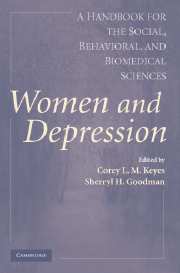Book contents
- Frontmatter
- Contents
- List of Contributors
- Foreword
- Preface
- PART I NOSOLOGY, MEASUREMENT, AND THE EPIDEMIOLOGY OF WOMEN AND DEPRESSION
- PART II BIOLOGICAL, DEVELOPMENTAL, AND AGING MODELS OF RISK
- 3 The Biological Underpinnings of Depression
- 4 Depressive Disorders in Women
- 5 Does Puberty Account for the Gender Differential in Depression?
- 6 Women's Aging and Depression
- PART III COGNITIVE, EMOTIONAL, AND INTERPERSONAL MODELS OF RISK
- PART IV SOCIAL, POLITICAL, AND ECONOMIC MODELS OF RISK
- PART V SYSTEMS AND PROCESSES OF TREATMENT, PREVENTION, AND POLICY
- Author Index
- Subject Index
- References
5 - Does Puberty Account for the Gender Differential in Depression?
Published online by Cambridge University Press: 05 June 2012
- Frontmatter
- Contents
- List of Contributors
- Foreword
- Preface
- PART I NOSOLOGY, MEASUREMENT, AND THE EPIDEMIOLOGY OF WOMEN AND DEPRESSION
- PART II BIOLOGICAL, DEVELOPMENTAL, AND AGING MODELS OF RISK
- 3 The Biological Underpinnings of Depression
- 4 Depressive Disorders in Women
- 5 Does Puberty Account for the Gender Differential in Depression?
- 6 Women's Aging and Depression
- PART III COGNITIVE, EMOTIONAL, AND INTERPERSONAL MODELS OF RISK
- PART IV SOCIAL, POLITICAL, AND ECONOMIC MODELS OF RISK
- PART V SYSTEMS AND PROCESSES OF TREATMENT, PREVENTION, AND POLICY
- Author Index
- Subject Index
- References
Summary
The period of pubertal development coincides with a dramatic shift in the prevalence rates of depression. As depressive disorders rise in general during adolescence, puberty seems to introduce a divergence between the genders. Rates of depression in girls and boys are nearly indistinguishable up until this period of life (Nolen-Hoeksema & Girgus, 1994). During the transition from middle childhood to adolescence, girls begin to experience depression at a higher rate than boys. By mid-adolescence, the gender difference in both subclinical levels of depressive symptoms and diagnosable unipolar depression is at the rate of about 2:1 for girls to boys, which persists through adulthood (Nolen-Hoeksema, 2001).
The entry into adolescence is marked by the hormonal and physical changes of puberty; social changes in the family, peer group, and school environment; and concomitant individual changes in cognitive and socioemotional functioning. It is therefore important to consider models that examine the biological, psychological, and social components of adolescence that may contribute to depressive outcomes (Graber & Brooks-Gunn, 1996). The research to date has focused more on biological changes, especially the timing of the biological changes, than on psychological and social changes as a mechanism for depressive outcomes. The purpose of this chapter is to review several different sets of proposed models that may explain the gender differential in depression that emerges during adolescence.
A number of theories have been proffered to explain why this emergence of gender differences occurs coincidentally with pubertal development.
- Type
- Chapter
- Information
- Women and DepressionA Handbook for the Social, Behavioral, and Biomedical Sciences, pp. 89 - 128Publisher: Cambridge University PressPrint publication year: 2006
References
- 11
- Cited by



